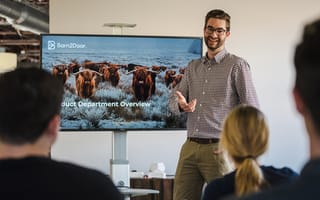It’s no great revelation that buyers love shopping online. Yet for all the glory of e-commerce, there are relatively few solutions that serve the same function as a farmers market when it comes to connecting producers with consumers.
“Farmer” is a broad term that covers agriculturalists ranging from backyard hobbyists to multi-state operators, and the industry has a complicated relationship with technology. Many harbor a certain level of skepticism, or may have never encountered a usable software selling solution before.
But regardless of farmers’ feelings toward newfangled tech, buyers expect to purchase goods online and Barn2Door aims to bridge the gap. The company is building a vertical SaaS e-commerce solution to allow farmers to sell food directly to consumers, wholesalers and chefs. The software helps automate workflows and syncs with outside logistics and bookkeeping services, while creating a virtual store for buyers to browse products and make purchases. But, considering the wide variety of food producers out there, there is a wildly complex matrix of use cases to entertain when building this kind of solution.
“Our solution needs to consider farmers across categories such as beef, dairy or microgreens, who are selling to different types of buyers such as schools, retailers and household consumers,” said product manager Anthony Maiocco. “Our platform is dealing with perishable, often seasonal, products that may be delivered to buyers’ doors, dropped off at a local pick-up site, or shipped nationally. Farmers may deal with seasonal inventory, inconsistent butcher dates or inclement weather that could wipe out their crops.”
According to Maiocco, it’s rewarding to distill these nuances into one streamlined service for such an essential industry. Built In Seattle sat down with him to dig into the challenges — and rewards — of serving an underserved industry.
Describe the industry landscape. What differentiates Barn2Door?
Most companies target a specific geography and aggregate and fulfill supply under the company’s brand and on its website. The software company is the go-to brand, and the cost structure and business model are the same as a brick-and-mortar grocery store. This is an expensive, logistics-heavy model with a middleman. It’s not optimized for local food or promoting farmers’ brands.
Barn2Door offers farmers an all-in-one solution to manage their businesses and provides their customers a convenient way to shop from that farmer online. We power farmers’ e-commerce on the front end, under the farmer’s own brand, and automate workflows on the back end.
Thousands of farmers across the country use our software to operate their websites and promote online ordering, including setting prices, marketing to customers and selling products effectively without having to sacrifice profit margins.
Give us an insider perspective of what it’s like being a tech company in an underserved industry.
Because this is a large industry, we have the opportunity to establish ourselves as the market leader while delivering a much-needed solution. It can cost more to educate the market, the pace of which is contingent upon the hunger of the industry for a solution.
An untapped market in a large industry means we have the opportunity to establish ourselves as the market leader.”
There is novelty and uncertainty in working in this vertical; farmer expectations and needs vary broadly. The baseline is e-commerce functionality, the expectations of which are shaped by established e-commerce providers. These are almost exclusively oriented toward a drop-ship consumer-packaged goods model.
At Barn2Door, when we think about basic e-commerce, we need to think beyond CPG and shipping. Selling farm-fresh food at a local level includes considerations such as the structure of the store and order management. Often, food is seasonal, items are sold by weight, and prices or unit sizes vary based on the type of buyer, from wholesale to retail.
What’s interesting or exciting about this industry and this work?
Farmers’ expectations include a longer list of nuances and use cases than you would imagine, but we can delight our customers by building in something they don’t expect: time savings. Beyond e-commerce, we help farmers stay organized while consolidating their workflows. It’s not just about sales: It’s also about managing logistics, syncing finances and automating marketing emails.
What is most exciting about this solution is that we have helped farmers save their farms. By helping them grow a sustainable business, we are in a position to make a difference in the daily lives of farmers. In my humble opinion, farming may be the most deserving industry to serve.

What are some challenges the company has had to overcome?
In an industry full of potential farmers who haven’t ever tried a software solution, you have to assume a certain level of skepticism. Many software companies sell a promise; at Barn2Door we had to deliver on that promise on day one. The software had to make a meaningful first impression to convince farmers of its value.
Early on, it was difficult to weigh which elements of the platform were mission-critical versus nice-to-have. We didn’t have the data. Large farms want different things than small farms, and a beef farmer may have different needs than an orchard owner. In some cases we built features that were too complex for the average farmer, while in others, they were too simple. We have to evaluate which features will serve the greatest number of farms.
Over time, that has been addressed through better communication between our support, success and product teams. We’ve improved feature request tracking and the feedback of power-user accounts to better consider the most important cases.
What is unique about product development in the agricultural industry?
We serve thousands of farms offering an incredible array of products: produce boxes, steak bundles, garlic samplers, honey, soap, fiber, mushrooms, seafood and maple syrup to name a few. Add to that a variety of fulfillment methods, payment methods and every type of subscription you can conceive of.
As a product manager, it is a wonderful challenge to boil all of these complexities down into a simple and delightful user experience. Usability is massive, as it must be suitably advanced for high-tech users, and simple enough for low-tech users.
As a product manager, it is a wonderful challenge to boil all of these complexities down into a simple and delightful user experience.”
Tell me about something you are particularly proud of accomplishing in your time with Barn2Door.
I’m excited about one of our most recent feature releases: custom tipping. This was a unique case where both farmers and buyers were asking for this feature.
In our industry, farmers enjoy strong relationships with their buyers, who are often enthusiastic to show support. The modern consumer is being conditioned to tip for everything, so it made sense to offer an extra source of income to our farmers. Seeing the material impact of that project was probably one of the most rewarding aspects of working here. Something as small for us as custom tipping can make a material difference for farmers’ bottom lines.
What appealed to you about Barn2Door? What does this work mean to you?
The company offers a real solution with meaningful impact to an underserved industry that greatly appreciates the work we do. Our internal board is chock-full of positive quotes from the farmers we help on a daily basis. That’s just on a normal day. When we deliver larger features or changes, it can be life-changing — no hyperbole. We are enabling farmers to start subscriptions, offer new methods of fulfillment and receive orders from new customers. This is a mission that pervades the company culture in an incredibly positive way.
When we deliver larger features or changes, it can be life-changing — no hyperbole.”
What should prospective job seekers know about working at Barn2Door?
Farmers are incredible, and we get to help them succeed. They face uncertain production that is dependent on the weather, manage perishable inventories and handle complicated logistics. At the same time they are building a brand and maintaining prompt communication with customers ranging from families to stores to distributors. Each relationship is negotiated at a different price point, with varying supply needs. Farmers do all of this in addition to the actual backbreaking work that goes into food production.
The environment here rewards the work we put in. Our engineers have ownership of the features they are developing. The success team interfaces with farms that are just starting up and those that have tens of thousands of followers. Our salespeople are navigating conversations across a broad range of farmers and products. Marketing leads collaborative and innovative campaigns. We’re growing and looking for ways to work better and harder to serve our farms. This approach, with humility and hunger to serve, has been spearheaded by our leadership. Our rise to the top of the industry speaks to the effectiveness of this strategy.






